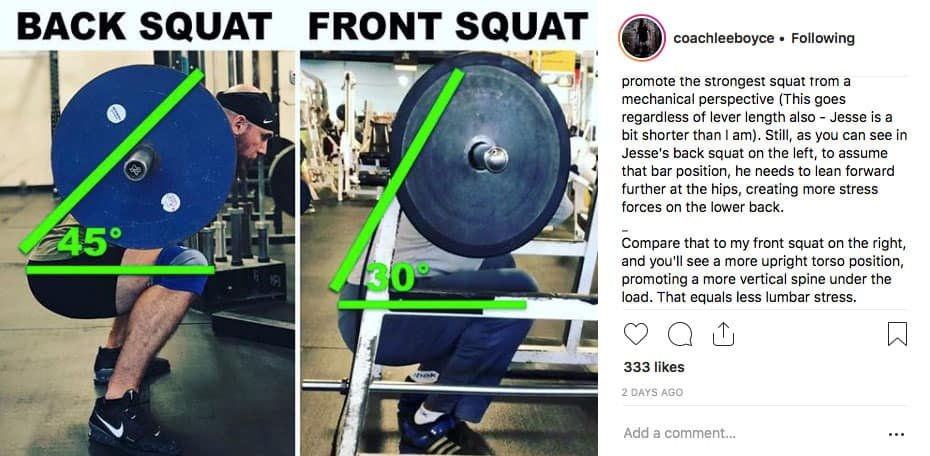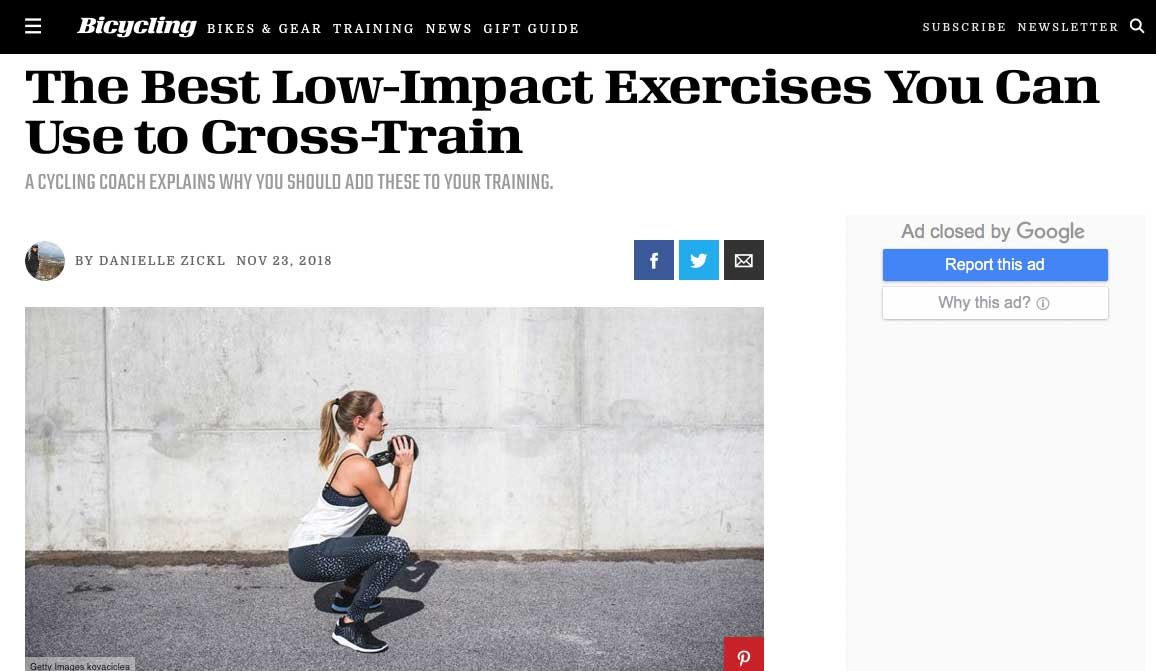Bicycling Magazine: The Best Strength Training & Kettlebell Exercises For Cyclists
Taking a look at the best low-impact strength training exercises for cyclists
If you’ve taken either of my Strength Training for Success courses on Training Peaks University, you know the importance of utilizing a full- body strength training program, and how to properly build & execute it. It may go against “common knowledge” but simply hitting the weights in movements and positions similar to your sport is NOT going to deliver best results. In fact, doing so can bring along overuse injuries in a hurried fashion, leaving you far more frustrated and even blaming strength training.
The missing piece, when it comes to strength training, for most athletes, is the understanding that strength training (and cross training for that matter) should be focused on strengthening the body in movements that are NOT done in their sport, and which will lead to better stability and strength through the sports movements. ESPECIALLY when we are talking about strength training for cyclists and triathletes.
Inherently, our sports require many many repetitions in movements in a relatively locked-in range of motion, which leads to many important stabilizing muscles of the body being left to the wayside, leaving them out of position, and out of strength to do their jobs properly.
While triathletes and cyclists have very different needs and programming when it comes to strength training, there are a few shared issues between the sports:
Long periods of time spent in an aggressive position on the bike, thus leading to poor posture and a need to strengthen the HINGE patter of the body
Learning and practicing Rotary Stability to help prevent back injuries, and boost performance

The good news is that there are a few simple moves that you can do at home, with just a Kettlebell and some space at home. While the article has Barbell Hip Thrust, which is a bit better as you can load heavier weight, a KB Hip Thrust offers similar benefits with lower weight, so you can suffer at home alone, if you prefer.
The Hip Thrust is a great exercise, when done properly, with a lot of benefits to cyclists, triathletes, and runners. This SHAPE magazine article I contributed to is a great place to learn the basics. I have a great post on Glutes and Hip Strength coming up soon, so make sure you stay tuned.
I’d like to give a little more detail to the exercises I recommended in a recent Bicycling Magazine Article, to help you understand the reasons why these exercises are so important to help you stay strong, healthy, and fast on the bike.
The Best Exercises For Cyclists
Breaking Down The Best Exercises for Cyclists: Why they matter
1. Kettle Bell Swing-
This is one of more difficult of the movements to teach, yet one of the most important. The Kettlebell swing not only allows us to train one of the most important, but most neglected FUNdamental 5-1 movements, the Hinge, but it also helps the athlete learn how to produce and regulate tension throughout the body as a whole.
This is so absolutely fundamental when it comes to sports performance, but the vast majority of riders (and triathletes, and runners!) in the world never learn this vital skill. Regulating and production of muscle tension is actually a huge determiner of athletic success, and this is one of the reasons why Olympic Lifts are at the core of every single sports preparation strength training program…. Yet for cyclists, in part due to the stigma that lifting weights will make one huge, and in part because of the ranges of motion needed to execute the lifts which most cyclists cannot safely execute due to severe muscular imbalances, Olympic lifts are not assigned.
The Kettlebell swing offers us a far safer, and more beneficial option with which to teach power and tension production via the whole body. It is a fantastic exercise- WHEN DONE PROPERLY.
It’s important to take the time to learn how to do these properly- with a straight spine, chin tucked, using the glutes and hamstring to produce the movement (not the back), while properly engaging the feet with the floor.
I have a video coming out soon on the YouTube channel to help you learn the Kettlebell swing, so be sure to pop over and subscribe.
2. Goblet Cyclist Squat-
What a fantastic way to both introduce the squat motion, and to expose imbalances that an athlete may have! I learned the Goblet Squat from Dan John, and a bit later from Dr. Stuart McGill. The Goblet Squat mostly mimics the joint positions of a front squat. which in and of itself is a great squat variation for cyclist and triathletes.

Both the Goblet Squat and the Front Squat allow the athlete to be in a more upright position, thus putting less shearing force on the lower back- something that MUST be a consideration for cyclists and triathletes, thanks in large part to shortened and tight hip flexors due to long hours riding the bike.
Another great benefit of the goblet squat, is that there are many variations we can use, as well as a number of “changes we can make to this relatively simple move, to make it more difficult or beneficial to the athlete.
Aim to keep your abs braced, shoulder blades back, and elbows inside your knees at the bottom. And remember, only go as far down as you can keep your back in a neutral position…no rounding the back to get to the bottom!
3. Around the Worlds-
While the video in the article itself is a very different variation of “Around the worlds” than the one I teach most athletes here at HVT, it does a great job of helping the athlete learn how to keep the hips and rib cage locked together, while getting rotary stability.
The variation I had in mind, is more of a shoulder mobility and strength exercise, as shown here in this HVT Technique Video that I use for those in the Monthly Membership Strength Training Groups, and HVT Personal Strength Athletes.
This variation allows you to learn how to get good, proper movement from the shoulder blades, while helping to learn what good, strong posture feels like.
4. Barbell Hip Thrust
A fantastic exercise for those looking to increase strength, power, or to simply look amazing in their wedding dress, the barbell hip thrust is a fantastic strength exercise for cyclists and triathletes, as it allows one to safely and effectively tap into, and grow, the glutes.
The glutes are often times neglected in athletic development, which can lead to a whole range of issues, including knee, back, and neck pain. When I first started HVT back in 2007, I put together a circuit of glute exercises as the baseline warmup for each and every athlete whom I worked with…boy has it paid off in gold!
Hip thrusters are a great, and relatively spine-safe way, to increase training load, and to help an athlete learn how to distinguish between hip extension, and extension from the lower back.
5. Suitcase Carry
Such an easy looking, yet deceptively hard exercise!
The Suitcase carry helps teach and reinforce rotary stability during gait (walking), which I’ve found translates over to riding immensely well.
There are a few common mistakes made that can significantly decrease the results you see. Tony Gentilcore has a great video on how to address these common mistakes. I wrote for tony about how to address common shoulder issues that we face as endurance athletes, you can check that out here. https://tonygentilcore.com/2018/05/endurance-athlete-can-appease-shoulder-hates/
6. Hiking, Snowshoeing, Cross Country Skiing
Get off the bike and DO SOMETHING ELSE!
As my athletes will tell you, I LOVE throwing in some “random sports”, but they really aren’t random at all. They are carefully selected for that athlete, at that time:
From Snowshoeing while away in Switzerland, to playing Racquetball 1x a week during the frigid winters instead of a track running session, cross training should be FUN, a BREAK FROM TRAINING MONOTONY, and challenge you in new ways, NOT done in your sport.
But you have to be smart and careful about this. Know yourself, and to yourself be true: If you had a shoulder injury during the triathlon season, racquetball may not be the best option for you. Talk with your coach to determine what areas you have that may put you at risk for injury, come up with a treatment & strength plan to get you better balanced, and find a cross-training tool that doesn’t put you at risk for injury.
Finding the best exercises for cyclists should be based around YOU and YOUR desired outcomes

As I spoke about in my Training Peaks University Strength Training for Cycling Success Course, programming is instrumental in getting the results you want and need, from your strength training. From the ordering of the exercises, to how to match the programming to your on-bike training. These are important ingredients that TRULY knock
To learn more about programming, and Strength Training for Cycling, you can take my self-paced online course.
https://trainingpeaks-university.thinkific.com/courses/strength-training-for-cycling-success
Orignal Article:
https://www.bicycling.com/training/a25170252/low-impact-exercises/







